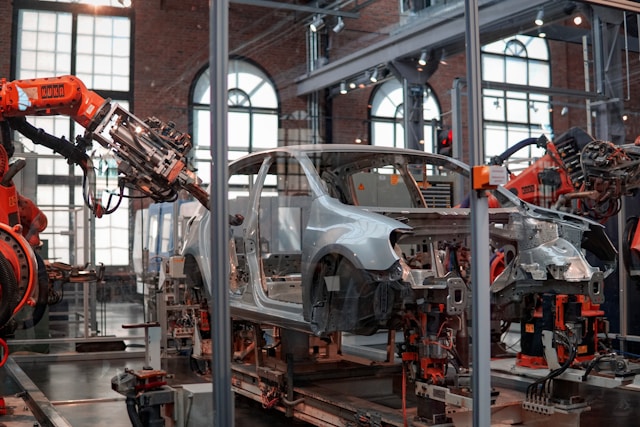Manufacturing, fundamentally rooted in innovation, serves as a cornerstone for economic development, workforce empowerment, and the creation of opportunities and prosperity.
Presently, the sector is experiencing an unprecedented transformation, influenced by shifts in consumer preferences, workforce dynamics, supply chain disruptions, technological advancements, and sustainability imperatives.
From its origins in the Industrial Revolution, manufacturing has evolved into a considerably intricate landscape, reflecting the dynamic and multifaceted nature of modern industrial operations.
In this article, we’ll explore key trends and innovations reshaping the future of manufacturing. We’ll also discuss how businesses are adapting and thriving in this dynamic environment.
Automation Revolutionizing Production Processes
Automation has emerged as a transformative force in manufacturing, significantly enhancing production processes and driving unprecedented levels of efficiency and productivity.
Integrating artificial intelligence (AI) and machine learning technologies into manufacturing workflows has enabled tasks to be executed with unparalleled speed, precision, and consistency.
Robotics, particularly robotic arms on assembly lines and autonomous guided vehicles in warehouses, play a prominent role in manufacturing. This automation trend is not only streamlining operations and reducing labor costs but also enhancing quality and safety standards.
The International Federation of Robotics highlights the escalating adoption of robotics in the manufacturing sector. Their findings reveal significant growth in the North American robotics market. Total installations in manufacturing surged by 12% to reach 41,624 units in 2022.
The automotive industry led the adoption, with 20,391 industrial robots installed in the US, Canada, and Mexico- a 30% increase from 2021.
With such trends, it’s evident that the manufacturing industry will witness even greater implementation of automation in the foreseeable future.
Sustainability as a Driving Force for Change
With the growing urgency to combat climate change, there’s a noticeable shift in consumer behavior toward prioritizing sustainability. According to Statista, in 2022, consumers worldwide were willing to pay an average sustainability premium of around 24% for eco-friendly consumer goods.
This indicates a willingness among shoppers to pay significantly more for sustainably produced items. Predictably, individuals with higher incomes showed a greater willingness to spend compared to those with average or lower incomes.
Consequently, manufacturers face mounting pressure to integrate eco-friendly practices across their operations. Sustainable manufacturing encompasses waste reduction, energy conservation, and environmental mitigation at every phase of production. This involves utilizing renewable resources, optimizing energy consumption, and implementing recycling initiatives.
Encouragingly, the momentum towards sustainability is gaining traction across various industries. Deloitte’s findings from 2022 indicate that 75% of organizations had ramped up their investments in sustainability initiatives.
By investing in sustainable technologies and equipment, manufacturers can significantly reduce their environmental footprint. This also helps them attract eco-conscious consumers and meet stricter regulatory requirements.
Equipment Financing Software Facilitating Growth
Amidst these transformative trends, businesses are faced with the challenge of acquiring the latest technologies and equipment to remain competitive in the market. However, the upfront costs associated with purchasing or upgrading equipment can pose a significant barrier to entry for many manufacturers. This is where equipment financing software comes into play.
Equipment financing software allows manufacturers to access capital for new equipment, technology upgrades, and infrastructure improvements. This avoids depleting their cash reserves or burdening themselves with excessive debt. This software provides flexible financing options tailored to businesses’ specific needs. It empowers manufacturers to acquire essential equipment while preserving liquidity and maintaining financial stability.
Trnsact notes that through equipment financing software platforms, manufacturers can explore a variety of financing options, including equipment loans, leases, and equipment-as-a-service (EaaS) models. These platforms streamline the application and approval process, allowing businesses to secure financing quickly and efficiently.
Moreover, equipment financing software provides valuable insights and analytics to help manufacturers make informed decisions about their equipment investments, optimizing ROI and driving long-term growth.
FAQs
What is equipment financing software?
Equipment financing software is a digital solution designed to streamline and manage the process of financing equipment for businesses. It facilitates the application, approval, and management of equipment financing, offering various features to assist both equipment vendors and businesses seeking financing.
How does equipment financing software work?
Equipment financing software typically automates various aspects of the financing process, including application submission, credit analysis, documentation management, and payment processing. It allows businesses to explore financing options, submit applications online, track the status of their applications, and manage their equipment financing agreements efficiently.
What types of financing options are available through equipment financing software?
Equipment financing software typically offers a range of financing options, including equipment loans, leases, and equipment-as-a-service (EaaS) models. These options allow businesses to acquire equipment with minimal upfront costs and flexible payment terms tailored to their specific needs.
In conclusion, as the manufacturing industry continues to evolve, embracing innovation and adapting to changing market dynamics are essential for success. By utilizing automation and sustainable practices, manufacturers can boost efficiency, cut costs, and meet customer and regulatory demands. Moreover, by utilizing equipment financing software, businesses can overcome financial barriers and unlock new opportunities for growth and expansion.
In this era of rapid tech advancement and changing preferences, manufacturing’s future favors those who innovate and embrace change. By adopting trends and investing in suitable equipment, manufacturers position themselves for success in modern manufacturing.

